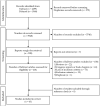Can Swallowing Cerebral Neurophysiology Be Evaluated during Ecological Food Intake Conditions? A Systematic Literature Review
- PMID: 36143127
- PMCID: PMC9505443
- DOI: 10.3390/jcm11185480
Can Swallowing Cerebral Neurophysiology Be Evaluated during Ecological Food Intake Conditions? A Systematic Literature Review
Abstract
Swallowing is a complex function that relies on both brainstem and cerebral control. Cerebral neurofunctional evaluations are mostly based on functional magnetic resonance imaging (fMRI) and positron emission tomography (PET), performed with the individual laying down; which is a non-ecological/non-natural position for swallowing. According to the PRISMA guidelines, a review of the non-invasive non-radiating neurofunctional tools, other than fMRI and PET, was conducted to explore the cerebral activity in swallowing during natural food intake, in accordance with the PRISMA guidelines. Using Embase and PubMed, we included human studies focusing on neurofunctional imaging during an ecologic swallowing task. From 5948 unique records, we retained 43 original articles, reporting on three different techniques: electroencephalography (EEG), magnetoencephalography (MEG) and functional near infra-red spectroscopy (fNIRS). During swallowing, all three techniques showed activity of the pericentral cortex. Variations were associated with the modality of the swallowing process (volitional or non-volitional) and the substance used (mostly water and saliva). All techniques have been used in both healthy and pathological conditions to explore the precise time course, localization or network structure of the swallowing cerebral activity, sometimes even more precisely than fMRI. EEG and MEG are the most advanced and mastered techniques but fNIRS is the most ready-to-use and the most therapeutically promising. Ongoing development of these techniques will support and improve our future understanding of the cerebral control of swallowing.
Keywords: cerebral activity; electroencephalography; fNIRS; magnetoencephalography; swallowing function.
Conflict of interest statement
The authors declare no conflict of interest.
Figures



References
Publication types
LinkOut - more resources
Full Text Sources

